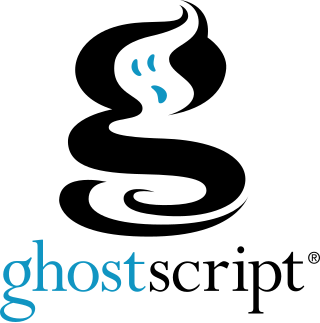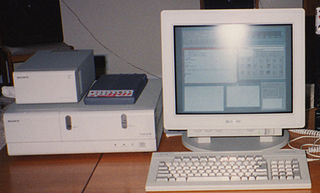
Ruby is an interpreted, high-level, general-purpose programming language. It was designed with an emphasis on programming productivity and simplicity. In Ruby, everything is an object, including primitive data types. It was developed in the mid-1990s by Yukihiro "Matz" Matsumoto in Japan.

Vim is a free and open-source, screen-based text editor program. It is an improved clone of Bill Joy's vi. Vim's author, Bram Moolenaar, derived Vim from a port of the Stevie editor for Amiga and released a version to the public in 1991. Vim is designed for use both from a command-line interface and as a standalone application in a graphical user interface. Since its release for the Amiga, cross-platform development has made it available on many other systems. In 2018, it was voted the most popular editor amongst Linux Journal readers; in 2015 the Stack Overflow developer survey found it to be the third most popular text editor, and in 2019 the fifth most popular development environment.

Yukihiro Matsumoto, also known as Matz, is a Japanese computer scientist and software programmer best known as the chief designer of the Ruby programming language and its original reference implementation, Matz's Ruby Interpreter (MRI). His demeanor has brought about a motto in the Ruby community: "Matz is nice and so we are nice," commonly abbreviated as MINASWAN.

Mac OS X Server is a series of discontinued Unix-like server operating systems developed by Apple Inc. based on macOS. It provided server functionality and system administration tools, and tools to manage both macOS-based computers and iOS-based devices, network services such as a mail transfer agent, AFP and SMB servers, an LDAP server, and a domain name server, as well as server applications including a Web server, database, and calendar server.

Ghostscript is a suite of software based on an interpreter for Adobe Systems' PostScript and Portable Document Format (PDF) page description languages. Its main purposes are the rasterization or rendering of such page description language files, for the display or printing of document pages, and the conversion between PostScript and PDF files.

4DOS is a command-line interpreter by JP Software, designed to replace the default command interpreter COMMAND.COM in Microsoft DOS and Windows. It was written by Rex C. Conn and Tom Rawson and first released in 1989. Compared to the default, it has a large number of enhancements.

Ruby on Rails is a server-side web application framework written in Ruby under the MIT License. Rails is a model–view–controller (MVC) framework, providing default structures for a database, a web service, and web pages. It encourages and facilitates the use of web standards such as JSON or XML for data transfer and HTML, CSS and JavaScript for user interfacing. In addition to MVC, Rails emphasizes the use of other well-known software engineering patterns and paradigms, including convention over configuration (CoC), don't repeat yourself (DRY), and the active record pattern.
JRuby is an implementation of the Ruby programming language atop the Java Virtual Machine, written largely in Java. It is free software released under a three-way EPL/GPL/LGPL license. JRuby is tightly integrated with Java to allow the embedding of the interpreter into any Java application with full two-way access between the Java and the Ruby code.

Jonathan Gillette, known by the pseudonym why the lucky stiff, is a writer, cartoonist, artist, and programmer notable for his work with the Ruby programming language. Annie Lowrey described him as "one of the most unusual, and beloved, computer programmers" in the world. Along with Yukihiro Matsumoto and David Heinemeier Hansson, he was seen as one of the key figures in the Ruby community. His pseudonym might allude to the exclamation "Why, the lucky stiff!" from The Fountainhead by Ayn Rand.
YARV is a bytecode interpreter that was developed for the Ruby programming language by Koichi Sasada. The goal of the project was to greatly reduce the execution time of Ruby programs.

The Sony NEWS is a series of Unix workstations sold during the late 1980s and 1990s. The first NEWS machine was the NWS-800, which originally appeared in Japan in January 1987 and was conceived as a desktop replacement for the VAX series of minicomputers.

Aptana, Inc. is a company that makes web application development tools for use with a variety of programming languages. Aptana's main products include Aptana Studio, Aptana Cloud and Aptana Jaxer.
Rubinius is an alternative Ruby implementation created by Evan Phoenix. Based loosely on the Smalltalk-80 Blue Book design, Rubinius seeks to "provide a rich, high-performance environment for running Ruby code."
IronRuby is an implementation of the Ruby programming language targeting Microsoft .NET Framework. It is implemented on top of the Dynamic Language Runtime (DLR), a library running on top of the Common Language Infrastructure that provides dynamic typing and dynamic method dispatch, among other things, for dynamic languages.
A global interpreter lock (GIL) is a mechanism used in computer-language interpreters to synchronize the execution of threads so that only one native thread can execute basic operations at a time. As a general rule, an interpreter that uses GIL will see only one thread to execute at a time, even if it runs on a multi-core processor, although some implementations provide for CPU intensive code to release the GIL, allowing multiple threads to use multiple cores. Some popular interpreters that have GIL are CPython and Ruby MRI.

The S-Lang programming library is a software library for Unix, Windows, VMS, OS/2, and Mac OS X. It provides routines for embedding an interpreter for the S-Lang scripting language, and components to facilitate the creation of text-based applications. The latter class of functions include routines for constructing and manipulating keymaps, an interactive line-editing facility, and both low- and high-level screen/terminal management functions. It is distributed under the terms of the GNU General Public License.

oVirt is a free, open-source virtualization management platform. It was founded by Red Hat as a community project on which Red Hat Virtualization is based. It allows centralized management of virtual machines, compute, storage and networking resources, from an easy-to-use web-based front-end with platform independent access. KVM on x86-64, PowerPC64 and s390x architecture are the only hypervisors supported, but there is an ongoing effort to support ARM architecture in a future releases.
The RubySpec project aimed to write a complete executable specification for the Ruby programming language. This project contains specs that describe Ruby language syntax and standard library classes. The project contains two main components:

mruby is an interpreter for the Ruby programming language with the intention of being lightweight and easily embeddable. The project is headed by Yukihiro Matsumoto, with over 100 contributors currently working on the project.
The history of the Ruby programming language began when Yukihiro Matsumoto first conceived of the language in 1993, then released it in 1995. Annual releases of the language often take place on Christmas Day. Interest in the language surged around 2005 because of the Ruby on Rails framework.













